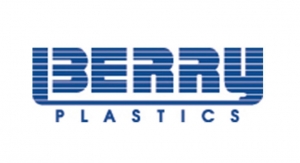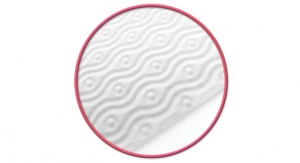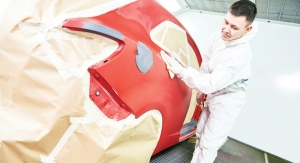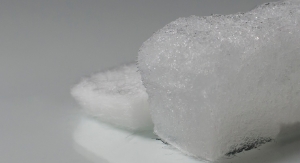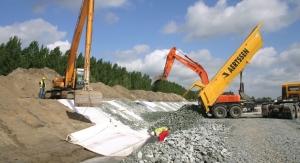Karen McIntyre, Editor12.07.18
It takes a village to make a hygiene product. From the absorbent material in the core to the acquisition and distribution layers to the side panels, backsheet, topsheet and waistbands, the many materials in the product needs to work in sync together to not only absorb waste but also to feel comfortable to the wearer. To achieve this, suppliers of materials like superabsorbents, films, adhesives, elastics and nonwovens are continuously tasked with making sure their product not only does its job but also works well with the other products within the chassis of the diaper or hygiene item.
In recent years, an increased focus on softness, thinness and fit has really raised the bar for hygiene components that not only need to meet these needs, they must meet them cost effectively and in the most sustainable way possible. This has led to the creation of new products, new partnerships and new technologies throughout the hygiene market supply chain.
“Looking ahead towards the future of the baby diaper, I envision a product that includes all the features from the past, such as thinness, comfortable fit and skin-friendliness, plus new attributes—namely safety and sustainability,” says Barbara Bulleri, vice president of marketing at Texsus SpA, a manufacturer of hygiene tapes as well as acquisition and distribution layer material for hygiene applications.
Another challenge facing suppliers is the increased importance of adult incontinence products and the growing popularity of pants style diapers, which both require design modifications throughout the product.
Berry Global has responded to these needs by broadening its product offering both through new product development and acquisition. The company significantly expanded it offerings to the hygiene space earlier this year when it purchased Clopay, a manufacturer of films for hygiene components and packaging applications.
“We really combined forces with a market leader, particularly how it relates to breathable films,” says executive vice president, global marketing and strategy, David Park. “It really fit squarely with our strategic plan and in a short period of time, it has proven to be very successful.”
Berry Global
As the largest producer of nonwovens in the world, Berry already had film technologies in its heritage portfolio prior to the Avintiv acquisition. But, as it continued to grow in the hygiene business, it found that stretchable film technology was lacking in its portfolio. Acquiring Clopay solved this problem.
“Clopay added a whole new dimension, not only with a strong existing base but also huge growth potential—when you think about the growth of adult incontinence and the stretchable side panels and waist bands,” Park adds. “This allowed us to offer more of an end-to-end solution for our customers so they are not buying nonwovens from one company and film from another.”
In fact, shortening the supply chain, in both hygiene and healthcare areas, has been Berry’s strategy since it acquired Avintiv’s nonwovens business. While Berry had had some presence in the hygiene and healthcare segment—from component films and packaging films—before acquiring a nonwovens business, joining these areas significantly strengthened its product offerings. The Clopay acquisition extended this even further.
“We are offering more of a one-stop shop where Berry has the capability to make the film, the nonwoven and assemble the laminate so you have a much more simplified solution,” Park says. “As you are taking steps out of the value chain, it represents value to our customers.”
Clopay has also helped Berry meet the need for ultra-soft premium products, a market trend that originated out of Asia a few years ago. In response to this trend, Berry has developed a range of ultra-soft nonwovens, based on both spunmelt and carded technologies, but the addition of Clopay’s Softflex line of films has allowed the company to offer softer, stronger backsheets.
Within its nonwovens business, Berry has announced a significant investment in Asia, which, combined with softer patterns and proprietary resin formulations, will allow it to offer ultrasoft products that can compete with the best of the best in that market area, Park says. “Soft still has a lot of miles on it because of the very high concentration and gold standard set in the Asian market, carrying those soft solutions around the globe,” Park says.
Berry recently did some consumer panel studies in the adult incontinence space to not only confirm how important softness is but to also point them in the direction of what is next and what are the unmet needs in the adult incontinence space. Two key topics weighing heavily on the minds of consumers are discretion and odor control.
Discretion plays right into Softflex’s wheelhouse which includes some soft and quiet film formulations that don’t rustle or crinkle.
Bostik Adhesive Solutions
Adhesive supplier Bostik launched Brilliance, a major technological leap forward in the use of polyolefins in high stress hot melt adhesive applications, two years ago. The adhesive is designed to hold elastic strands in place in diapers and adult incontinence items. The bonding of elastic strands in these products is critical to the function and fit of the disposable product.
“We launched Brilliance and it is a world first and its something we are still understanding….all of the advantages it could bring…odor is a big trend around the market where manufacturers are looking for the lowest odor in their products and we think Brilliance can help,” says Diane Toonen, global director of strategic marketing.
Additionally, the flexibility of the material allows the manufacturer to use different substrates, different elastics, different applicators and more. “It really allows our customers to use the highest level of performance and use many different materials,” says global marketing manager Courtney Korselt. “As always adhesives are the enabler for some of the other materials that fit into those trends and we see Brilliance really meeting these demands.”
Brilliance has already allowed Bostik to expand its offerings into the elastics area, which has become important as more pants-style diapers enter the market. This diaper design requires a lot more elastics and the strands tend to be thinner and closer together. “The adhesive requirements are so much different—maintaining crepe, allowing retraction, maintaining feel…for those products,” Korselt says. “Adhesives can contribute very positively to softness when you have all those trends. Even though the adhesive is only a smaller percentage of the product, you need it to make the whole product work.”
As design trends shift in terms of softness and thinness, the adhesive’s role becomes more important. Bostik’s product lineup can respond to all of these trends.
“We are constantly looking at how we can continue to analyze and understand what is in the adhesives at a really low level, not that it is not safe, but understanding those things that impact consumer perception,” Toonen says.
The role of enabler that adhesives play means that it plays a role in all aspects of product design. As many hygiene manufacturers are examining their green profile, Bostik works with them on how they can help reduce the amount of material used within the diaper. Sometimes this means figuring out how an adhesive can work with a different type of substrate or core material.
“Sometimes we have to look at all of the other materials that make a product eco-friendly and figure out how we can enable all of these materials to work together,” Toonen says. “We are not blinded to the fact that sometimes adhesives are not the most fun thing to put into your operation but we are focused on taking the challenges away. If you want to swap in a substrate you can have that flexibility.”
Colquimica
Colquimica Adhesives continues to develop its adhesives lineup to respond to the expectations of different consumers, seeking to develop hot melts that promote flexibility, resistance, integrity, durability, humidity, strength and firmness, cost effectiveness and sustainability.
“To adapt to the design of the diaper, adhesives must guarantee flexibility and adherence to the body,” says vice president Sofia Koehler. “Resistance and adaptation to movement and integrity guarantee that the diaper core stays perfect.”
Hygiene customers are looking for adhesive producers that guarantee safety, that guarantee long-term supply availability, who are innovative leaders and who develop adhesives that meet consumers’ market trends. They are also looking for price security, choosing adhesive producers that have a solid position in the market.
Koehler adds that the search for more sustainable raw materials has increased, forcing adhesive suppliers to innovate. Proof of this are the developments that Colquimica Adhesives has made to introduce an innovative hot melt for the construction of diapers and feminine pads like Spraycare, one of the first ranges of products in the industry with a high enough polymer content for applications that can be sprayed at very low temperatures. This technology proves to be the most sustainable offering because it replaces a high percentage of the synthetic tackifiers and the rubber polymers as a whole.
Spraycare adhesives also have low density, high peel, a very light color and an imperceptible odor. The high thermal stability as well as the high performance in state-of-the-art machines make Spraycare glues the most innovative option for the construction applications of disposable products, Koehler adds.
H.B. Fuller
H.B. Fuller’s adhesives can improve the key functional requirements of a disposable article, such as leakage protection by providing extra integrity to the absorbent core with specialty core adhesives or enhancing fit with creep-resistant adhesive for leg and cuff elastic attachments. For example, its Full-Care 7800 series of adhesives for channel formation in absorbent cores. This adhesive technology has high dry and wet peel performance and excellent cohesion strength, enabling customers to create permanent core channels as a feature of differentiation in the market place.
“We also contribute to the improvement of consumer sensory experiences with disposable hygiene articles through adhesive technologies that enable bonding of softer and loftier substrates and products with improved odor and desired color,” says Julia Li, global marketing manager.
As consumer preference and rising material prices have influenced a shift toward thinner cores with little or no fluff, H.B. Fuller has developed specialty core adhesives combining deep penetration with excellent wet strength and mechanical anchoring properties.
Meanwhile, other products like the Full-Care 9500 series wetness indicator provides distinct and noticeable indication in the presence of moisture, helping to reduce waste by ensuring caretakers change the product only when it is necessary.
“H.B. Fuller adhesives also play a vital role in enabling customers to transition to sustainable, natural substrates that prove to be difficult to bond,” Li says. “We strive to be proactive in foreseeing the difficulties that our customers might face with transitioning to the newer substrates and find effective solutions to help them create differentiated products that are poised to address evolving consumer needs.”
To address demand for thinner, softer, better fitting and more discreet products, H.B. Fuller developed Conforma adhesive technology which has stretch and retraction properties. This technology has recently been used in an absorbent core to strengthen core integrity and reduce bunching. “This idea stemmed from our extensive voice-of-consumer study and diaper testing research, which revealed leakage to be the key consumer complaint among consumers of baby and adult diapers,” Li adds.
Texsus
A heightened concern on product safety in what Texsus’ Bulleri, s, calls the chemophobic era for the hygienic disposable market and increased sustainability are top on the list of concerns of hygiene manufacturers globally.
“Texsus answers this request with strict quality control protocols, both internal and external, aimed at ensuring that all materials in our products are safe for consumers, for the employees and for the environment,” says Bulleri. “For example, all fibers are certified for hygienic applications and are compliant with Reach, Oekotex 100 class, cytotoxicity and skin irritation standards, conformity declaration standards and other relevant standards for the industry. Internal company procedures ensure a constant monitoring to detect critical chemical substances in the procured raw materials.”
When it comes sustainable products, Texsus believes it’s important to reduce its footprint and maximize its handprint on society and has fully embraced the principle of a circular economy using, in its processes, more sustainable raw materials such as r-PET fibers or natural fibers. “Employing this kind of fiber offer is an important environmental benefit over virgin raw materials, and depending on the allocation methods applied for recycling, the use of rPET gives a 25-75% savings on global-warming potential (measured in tons of equivalent CO2 emissions),” Bulleri says.
When it comes to product design, more diapers feature a new core design with channels in diapers in Europe and North America. The channel core ensures a good fitting and increased flexibility when the diaper is wet. It’s fundamental, however, to closely monitor fluid distribution inside the diaper, as pairing with an appropriate ADL is key to ensure dryness. Diaper performance can be controlled with a properly designed core and an adequate selection of all adjoining layers comprising the diaper structure, Bulleri says, adding that Texsus has used its decades-long experience in the design of ADL to assist baby diaper producers to reach the highest performance from their products.
“Texsus has developed ADLs designed with the channel core structure in mind, as well as for glue-less diapers and adult pads,” she adds. “Moreover, we are commercializing an ADL with low Antimony content, and we are soon going to launch on the market a completely Antimony free option, answering the request for a ‘chemicals-free’ finished product.”
In feminine hygiene, Texsus is contributing to the innovation with its Be-DRY product. This is an innovative, combined structure containing a topsheet and acquisition distribution layer. This innovative solution is able to deliver the dryness of a perforated film liner, paired with a 100% high loft nonwoven structure. The Be-DRY offers a sustainable approach for the feminine hygiene market due to a lesser amount of energy consumption required to produce, transport, store, and convert the material.
Air through bonding technology is synonym of bulkiness, softness and aesthetic appeal in hygiene applications. Texsus is contributing to the market’s request for softness with the “cushioning softness” of its highly resilient ADL layer, the “touch and visual softness” of its embossed and perforated liners, and through the “skin-friendly softness” of its Sloopy frontal tape.
Last year, Texsus introduced Sloopy frontal tape to the global hygiene market. The product has been specifically designed to offer a high performing, sustainable, soft and three-dimensional option that was sorely missing from the frontal tape market. The Sloopy has a low impact on the environment thanks to its light weight, absence of glue and for being completely recyclable.
Technical Absorbents Limited
Technical Absorbents manufactures superabsorbent (SAF) fibers, using a unique process that spins the polymer to produce a staple fiber that can then be used to produce either fabric or yarn.
According to Commercial Director Paul Rushton, there has been an increasing demand for high performing superabsorbent fabrics, particularly from Asia in countries such as China, Japan and South Korea where consumers are looking for high performance products, both terms of absorption and comfort.
“There are significant advantages, not only when considering comfort and confirmability, but also during the manufacturing process where process steps can be eliminated and raw material costs reduced” Rushton says. “SAF can be used to make carded thermobond or air through nonwovens which are very light, breathable and have good absorbency. As a result of the fibre being fully integrated into the fabric, gel leakage is not an issue when it takes on liquid.
Also, compared to a superabsorbent powder core, where the powder is typically laminated between two sheets, the layer is more rigid and less malleable than when using a SAF nonwoven. “Powder is not distributed uniformly —it tends to move about and can also escape so it is not ideal in these types of product” Rushton says.
The demand for high performance, more sophisticated hygiene products is being led by consumers in Asia. Typically the fibres manufactured by Technical Absorbents are incorporated into premium products at the top end of the market.
“Given the already high demand in Asia, it is noticeable how SAF technology is gaining traction globally. A number of major players in the hygiene sector are working on development programmes that will see the more widespread use of SAF in the very near future.” Rushton adds that is it is interesting to watch the evolution of super absorbents in geographies around the globe as initially rudimentary technology makes way for powders then onto consideration of the use of SAF.
In more sophisticated hygiene markets, Technical Absorbents, which is also a needlepunch nonwovens manufacturer, has been working with customers to make reusable diapers and feminine hygiene products using nonwovens materials incorporating superabsorbent fibers.
“We are working with global partners that can convert SAF into various types of nonwovens made to our specification. Interest is currently very high in washable adult incontinence and feminine hygiene products that can be laundered multiple times,” Rushton adds. “This plays into the need for more sustainable solutions easing the market’s impact on the environment.”
Tethis
A group of researchers have developed a sustainably sourced superabsorbent material, which, while about two-and-a-half years away from commercial production, could have a serious impact on the disposable hygiene market. The SAP material, named Tethex, is made from a starch-based feedstock and offers a biodegradable sustainable option to current absorbents used in the hygiene industry. “Our current focus is the hygiene industry—baby diapers feminine hygiene products and incontinence,” says vice president of sales and marketing Tyler Tibbits. “This is where we spend the vast majority of our business development time but we are working on projects in all types of industries taking the base technology and using it in very different environments.”
In hygiene, Tethis researchers are looking to establish a product line that can be used on a mass market scale either as a complement to synthetic materials in certain applications or as a complete replacement in other areas.
“We are looking at blending and being a replacement or option for fully compostable diapers today,” he adds.
Tethis has already raised $17.6 million in private equity financing to start up a pilot line which is helping researchers understand the processing parameters of the technology. In the early stages of working with potential customers, Tethis has been shipping pilot lots from its start-up facility in Raleigh, NC. This has allowed makers of feminine hygiene pads and other disposable absorbent materials to see how well Tethex works in the material.
“Potential customers can try out the superabsorbent polymer in their own products to see how well it works,” says Tibbits. “When it does reach commercialization, we will be able to hit the ground running.”
So far, Tethis has seen interest in incorporating Tethex into the absorbent core of the hygiene product as the industry continues to look for sustainable alternatives. “What we are selling is not a superior price point or a superior performance claim but we do have a superior sustainability claim,” Tibbits says. “That is what we are selling.”
Based on preliminary studies that measure biodegradability, Tethex experiences 90% of complete biodegradation in 82 days. The company is also examining the polymer’s performance in backyard composts and other disposal methods.
Tredegar Personal Care
Tredegar Personal Care provides topsheet, acquisition layer, and elastic films and laminated fabrics for use in feminine, baby, and adult care applications. The most significant evolution in Tredegar’s product offerings has been an intense focus on the comfort of users regardless of whether they are active or resting. It is Tredegar Personal Care’s goal to help all people live their lives with confidence and dignity.
Last year, Tredegar announced it was expanding its Indiana site to increase capacity for FlexAire technology. The FlexAire technology provides breathable elastic fabrics with customized stretch regions that enable its customers to design disposable garments that are nearly indistinguishable from conventional underwear. The expanded capacity and technical capability Tredegar is installing in Indiana will help serve both baby and adult hygiene markets.
Global director of product development Matt O’Sickey says that one of the key challenges that producers of disposable absorbent hygiene materials face is being able to provide an “underwear-like” experience at a disposable price. It is the challenge of how transition hygiene products from being somewhat medical in nature to being part of everyday life at an acceptable cost.
For raw material suppliers this has moved comfort from being a nice-to-have to now being a primary design criterion and decisively underscored the importance of cost. Competition continues to evolve in all categories of raw materials as both competitors and customers shift from being regional players towards being multi-nationals.
To meet the need for soft, comfortable and more natural feeling products, Tredegar has invested (for baby, feminine, and adult care) in development of breathable elastic films and fabrics, highly conformable and pleasant feeling topsheets, and softer, flexible, exceptionally dry surge layers. In each case, Tredegar has also invested in technologies that allow it to drive cost out of these categories via manufacturing excellence and/or material source reduction.
And, in an effort to streamline its business, Tredegar decided to close its Shanghai, China, site because the technologies available there were not well suited to meet these needs. For now, Tredegar will serve the Asian markets from sites with more appropriate technology, including India, Europe, and the U.S.
“We continue to grow our business in Asia with elastic films, breathable elastic fabrics, and soft, conformable topsheets and acquisition layers sourced from these locations (FlexAire breathable elastic fabrics, ComfortFeel Supreme topsheets, Soft&Sure topsheets, and AquiSoft acquisition distribution layers),” O’Sickey says.
Tredegar has an active and long history with various eco-friendly approaches to disposable hygiene products, ranging from work with compostable options for backsheets in the early 2000s, sourcing film and nonwoven raw materials from renewable sources, and aggressively engaging in source reduction efforts across its product lines.
One of the most significant challenges it has experienced is the lack of industry or market standards that would help make these initiatives more focused and effective in delivering meaningful eco-friendly solutions to consumers. To that extent, Tredegar engages with trade associations, such as INDA and EDANA to help develop and drive an aligned vision and set of industry standards, he adds.
In recent years, an increased focus on softness, thinness and fit has really raised the bar for hygiene components that not only need to meet these needs, they must meet them cost effectively and in the most sustainable way possible. This has led to the creation of new products, new partnerships and new technologies throughout the hygiene market supply chain.
“Looking ahead towards the future of the baby diaper, I envision a product that includes all the features from the past, such as thinness, comfortable fit and skin-friendliness, plus new attributes—namely safety and sustainability,” says Barbara Bulleri, vice president of marketing at Texsus SpA, a manufacturer of hygiene tapes as well as acquisition and distribution layer material for hygiene applications.
Another challenge facing suppliers is the increased importance of adult incontinence products and the growing popularity of pants style diapers, which both require design modifications throughout the product.
Berry Global has responded to these needs by broadening its product offering both through new product development and acquisition. The company significantly expanded it offerings to the hygiene space earlier this year when it purchased Clopay, a manufacturer of films for hygiene components and packaging applications.
“We really combined forces with a market leader, particularly how it relates to breathable films,” says executive vice president, global marketing and strategy, David Park. “It really fit squarely with our strategic plan and in a short period of time, it has proven to be very successful.”
Berry Global
As the largest producer of nonwovens in the world, Berry already had film technologies in its heritage portfolio prior to the Avintiv acquisition. But, as it continued to grow in the hygiene business, it found that stretchable film technology was lacking in its portfolio. Acquiring Clopay solved this problem.
“Clopay added a whole new dimension, not only with a strong existing base but also huge growth potential—when you think about the growth of adult incontinence and the stretchable side panels and waist bands,” Park adds. “This allowed us to offer more of an end-to-end solution for our customers so they are not buying nonwovens from one company and film from another.”
In fact, shortening the supply chain, in both hygiene and healthcare areas, has been Berry’s strategy since it acquired Avintiv’s nonwovens business. While Berry had had some presence in the hygiene and healthcare segment—from component films and packaging films—before acquiring a nonwovens business, joining these areas significantly strengthened its product offerings. The Clopay acquisition extended this even further.
“We are offering more of a one-stop shop where Berry has the capability to make the film, the nonwoven and assemble the laminate so you have a much more simplified solution,” Park says. “As you are taking steps out of the value chain, it represents value to our customers.”
Clopay has also helped Berry meet the need for ultra-soft premium products, a market trend that originated out of Asia a few years ago. In response to this trend, Berry has developed a range of ultra-soft nonwovens, based on both spunmelt and carded technologies, but the addition of Clopay’s Softflex line of films has allowed the company to offer softer, stronger backsheets.
Within its nonwovens business, Berry has announced a significant investment in Asia, which, combined with softer patterns and proprietary resin formulations, will allow it to offer ultrasoft products that can compete with the best of the best in that market area, Park says. “Soft still has a lot of miles on it because of the very high concentration and gold standard set in the Asian market, carrying those soft solutions around the globe,” Park says.
Berry recently did some consumer panel studies in the adult incontinence space to not only confirm how important softness is but to also point them in the direction of what is next and what are the unmet needs in the adult incontinence space. Two key topics weighing heavily on the minds of consumers are discretion and odor control.
Discretion plays right into Softflex’s wheelhouse which includes some soft and quiet film formulations that don’t rustle or crinkle.
Bostik Adhesive Solutions
Adhesive supplier Bostik launched Brilliance, a major technological leap forward in the use of polyolefins in high stress hot melt adhesive applications, two years ago. The adhesive is designed to hold elastic strands in place in diapers and adult incontinence items. The bonding of elastic strands in these products is critical to the function and fit of the disposable product.
“We launched Brilliance and it is a world first and its something we are still understanding….all of the advantages it could bring…odor is a big trend around the market where manufacturers are looking for the lowest odor in their products and we think Brilliance can help,” says Diane Toonen, global director of strategic marketing.
Additionally, the flexibility of the material allows the manufacturer to use different substrates, different elastics, different applicators and more. “It really allows our customers to use the highest level of performance and use many different materials,” says global marketing manager Courtney Korselt. “As always adhesives are the enabler for some of the other materials that fit into those trends and we see Brilliance really meeting these demands.”
Brilliance has already allowed Bostik to expand its offerings into the elastics area, which has become important as more pants-style diapers enter the market. This diaper design requires a lot more elastics and the strands tend to be thinner and closer together. “The adhesive requirements are so much different—maintaining crepe, allowing retraction, maintaining feel…for those products,” Korselt says. “Adhesives can contribute very positively to softness when you have all those trends. Even though the adhesive is only a smaller percentage of the product, you need it to make the whole product work.”
As design trends shift in terms of softness and thinness, the adhesive’s role becomes more important. Bostik’s product lineup can respond to all of these trends.
“We are constantly looking at how we can continue to analyze and understand what is in the adhesives at a really low level, not that it is not safe, but understanding those things that impact consumer perception,” Toonen says.
The role of enabler that adhesives play means that it plays a role in all aspects of product design. As many hygiene manufacturers are examining their green profile, Bostik works with them on how they can help reduce the amount of material used within the diaper. Sometimes this means figuring out how an adhesive can work with a different type of substrate or core material.
“Sometimes we have to look at all of the other materials that make a product eco-friendly and figure out how we can enable all of these materials to work together,” Toonen says. “We are not blinded to the fact that sometimes adhesives are not the most fun thing to put into your operation but we are focused on taking the challenges away. If you want to swap in a substrate you can have that flexibility.”
Colquimica
Colquimica Adhesives continues to develop its adhesives lineup to respond to the expectations of different consumers, seeking to develop hot melts that promote flexibility, resistance, integrity, durability, humidity, strength and firmness, cost effectiveness and sustainability.
“To adapt to the design of the diaper, adhesives must guarantee flexibility and adherence to the body,” says vice president Sofia Koehler. “Resistance and adaptation to movement and integrity guarantee that the diaper core stays perfect.”
Hygiene customers are looking for adhesive producers that guarantee safety, that guarantee long-term supply availability, who are innovative leaders and who develop adhesives that meet consumers’ market trends. They are also looking for price security, choosing adhesive producers that have a solid position in the market.
Koehler adds that the search for more sustainable raw materials has increased, forcing adhesive suppliers to innovate. Proof of this are the developments that Colquimica Adhesives has made to introduce an innovative hot melt for the construction of diapers and feminine pads like Spraycare, one of the first ranges of products in the industry with a high enough polymer content for applications that can be sprayed at very low temperatures. This technology proves to be the most sustainable offering because it replaces a high percentage of the synthetic tackifiers and the rubber polymers as a whole.
Spraycare adhesives also have low density, high peel, a very light color and an imperceptible odor. The high thermal stability as well as the high performance in state-of-the-art machines make Spraycare glues the most innovative option for the construction applications of disposable products, Koehler adds.
H.B. Fuller
H.B. Fuller’s adhesives can improve the key functional requirements of a disposable article, such as leakage protection by providing extra integrity to the absorbent core with specialty core adhesives or enhancing fit with creep-resistant adhesive for leg and cuff elastic attachments. For example, its Full-Care 7800 series of adhesives for channel formation in absorbent cores. This adhesive technology has high dry and wet peel performance and excellent cohesion strength, enabling customers to create permanent core channels as a feature of differentiation in the market place.
“We also contribute to the improvement of consumer sensory experiences with disposable hygiene articles through adhesive technologies that enable bonding of softer and loftier substrates and products with improved odor and desired color,” says Julia Li, global marketing manager.
As consumer preference and rising material prices have influenced a shift toward thinner cores with little or no fluff, H.B. Fuller has developed specialty core adhesives combining deep penetration with excellent wet strength and mechanical anchoring properties.
Meanwhile, other products like the Full-Care 9500 series wetness indicator provides distinct and noticeable indication in the presence of moisture, helping to reduce waste by ensuring caretakers change the product only when it is necessary.
“H.B. Fuller adhesives also play a vital role in enabling customers to transition to sustainable, natural substrates that prove to be difficult to bond,” Li says. “We strive to be proactive in foreseeing the difficulties that our customers might face with transitioning to the newer substrates and find effective solutions to help them create differentiated products that are poised to address evolving consumer needs.”
To address demand for thinner, softer, better fitting and more discreet products, H.B. Fuller developed Conforma adhesive technology which has stretch and retraction properties. This technology has recently been used in an absorbent core to strengthen core integrity and reduce bunching. “This idea stemmed from our extensive voice-of-consumer study and diaper testing research, which revealed leakage to be the key consumer complaint among consumers of baby and adult diapers,” Li adds.
Texsus
A heightened concern on product safety in what Texsus’ Bulleri, s, calls the chemophobic era for the hygienic disposable market and increased sustainability are top on the list of concerns of hygiene manufacturers globally.
“Texsus answers this request with strict quality control protocols, both internal and external, aimed at ensuring that all materials in our products are safe for consumers, for the employees and for the environment,” says Bulleri. “For example, all fibers are certified for hygienic applications and are compliant with Reach, Oekotex 100 class, cytotoxicity and skin irritation standards, conformity declaration standards and other relevant standards for the industry. Internal company procedures ensure a constant monitoring to detect critical chemical substances in the procured raw materials.”
When it comes sustainable products, Texsus believes it’s important to reduce its footprint and maximize its handprint on society and has fully embraced the principle of a circular economy using, in its processes, more sustainable raw materials such as r-PET fibers or natural fibers. “Employing this kind of fiber offer is an important environmental benefit over virgin raw materials, and depending on the allocation methods applied for recycling, the use of rPET gives a 25-75% savings on global-warming potential (measured in tons of equivalent CO2 emissions),” Bulleri says.
When it comes to product design, more diapers feature a new core design with channels in diapers in Europe and North America. The channel core ensures a good fitting and increased flexibility when the diaper is wet. It’s fundamental, however, to closely monitor fluid distribution inside the diaper, as pairing with an appropriate ADL is key to ensure dryness. Diaper performance can be controlled with a properly designed core and an adequate selection of all adjoining layers comprising the diaper structure, Bulleri says, adding that Texsus has used its decades-long experience in the design of ADL to assist baby diaper producers to reach the highest performance from their products.
“Texsus has developed ADLs designed with the channel core structure in mind, as well as for glue-less diapers and adult pads,” she adds. “Moreover, we are commercializing an ADL with low Antimony content, and we are soon going to launch on the market a completely Antimony free option, answering the request for a ‘chemicals-free’ finished product.”
In feminine hygiene, Texsus is contributing to the innovation with its Be-DRY product. This is an innovative, combined structure containing a topsheet and acquisition distribution layer. This innovative solution is able to deliver the dryness of a perforated film liner, paired with a 100% high loft nonwoven structure. The Be-DRY offers a sustainable approach for the feminine hygiene market due to a lesser amount of energy consumption required to produce, transport, store, and convert the material.
Air through bonding technology is synonym of bulkiness, softness and aesthetic appeal in hygiene applications. Texsus is contributing to the market’s request for softness with the “cushioning softness” of its highly resilient ADL layer, the “touch and visual softness” of its embossed and perforated liners, and through the “skin-friendly softness” of its Sloopy frontal tape.
Last year, Texsus introduced Sloopy frontal tape to the global hygiene market. The product has been specifically designed to offer a high performing, sustainable, soft and three-dimensional option that was sorely missing from the frontal tape market. The Sloopy has a low impact on the environment thanks to its light weight, absence of glue and for being completely recyclable.
Technical Absorbents Limited
Technical Absorbents manufactures superabsorbent (SAF) fibers, using a unique process that spins the polymer to produce a staple fiber that can then be used to produce either fabric or yarn.
According to Commercial Director Paul Rushton, there has been an increasing demand for high performing superabsorbent fabrics, particularly from Asia in countries such as China, Japan and South Korea where consumers are looking for high performance products, both terms of absorption and comfort.
“There are significant advantages, not only when considering comfort and confirmability, but also during the manufacturing process where process steps can be eliminated and raw material costs reduced” Rushton says. “SAF can be used to make carded thermobond or air through nonwovens which are very light, breathable and have good absorbency. As a result of the fibre being fully integrated into the fabric, gel leakage is not an issue when it takes on liquid.
Also, compared to a superabsorbent powder core, where the powder is typically laminated between two sheets, the layer is more rigid and less malleable than when using a SAF nonwoven. “Powder is not distributed uniformly —it tends to move about and can also escape so it is not ideal in these types of product” Rushton says.
The demand for high performance, more sophisticated hygiene products is being led by consumers in Asia. Typically the fibres manufactured by Technical Absorbents are incorporated into premium products at the top end of the market.
“Given the already high demand in Asia, it is noticeable how SAF technology is gaining traction globally. A number of major players in the hygiene sector are working on development programmes that will see the more widespread use of SAF in the very near future.” Rushton adds that is it is interesting to watch the evolution of super absorbents in geographies around the globe as initially rudimentary technology makes way for powders then onto consideration of the use of SAF.
In more sophisticated hygiene markets, Technical Absorbents, which is also a needlepunch nonwovens manufacturer, has been working with customers to make reusable diapers and feminine hygiene products using nonwovens materials incorporating superabsorbent fibers.
“We are working with global partners that can convert SAF into various types of nonwovens made to our specification. Interest is currently very high in washable adult incontinence and feminine hygiene products that can be laundered multiple times,” Rushton adds. “This plays into the need for more sustainable solutions easing the market’s impact on the environment.”
Tethis
A group of researchers have developed a sustainably sourced superabsorbent material, which, while about two-and-a-half years away from commercial production, could have a serious impact on the disposable hygiene market. The SAP material, named Tethex, is made from a starch-based feedstock and offers a biodegradable sustainable option to current absorbents used in the hygiene industry. “Our current focus is the hygiene industry—baby diapers feminine hygiene products and incontinence,” says vice president of sales and marketing Tyler Tibbits. “This is where we spend the vast majority of our business development time but we are working on projects in all types of industries taking the base technology and using it in very different environments.”
In hygiene, Tethis researchers are looking to establish a product line that can be used on a mass market scale either as a complement to synthetic materials in certain applications or as a complete replacement in other areas.
“We are looking at blending and being a replacement or option for fully compostable diapers today,” he adds.
Tethis has already raised $17.6 million in private equity financing to start up a pilot line which is helping researchers understand the processing parameters of the technology. In the early stages of working with potential customers, Tethis has been shipping pilot lots from its start-up facility in Raleigh, NC. This has allowed makers of feminine hygiene pads and other disposable absorbent materials to see how well Tethex works in the material.
“Potential customers can try out the superabsorbent polymer in their own products to see how well it works,” says Tibbits. “When it does reach commercialization, we will be able to hit the ground running.”
So far, Tethis has seen interest in incorporating Tethex into the absorbent core of the hygiene product as the industry continues to look for sustainable alternatives. “What we are selling is not a superior price point or a superior performance claim but we do have a superior sustainability claim,” Tibbits says. “That is what we are selling.”
Based on preliminary studies that measure biodegradability, Tethex experiences 90% of complete biodegradation in 82 days. The company is also examining the polymer’s performance in backyard composts and other disposal methods.
Tredegar Personal Care
Tredegar Personal Care provides topsheet, acquisition layer, and elastic films and laminated fabrics for use in feminine, baby, and adult care applications. The most significant evolution in Tredegar’s product offerings has been an intense focus on the comfort of users regardless of whether they are active or resting. It is Tredegar Personal Care’s goal to help all people live their lives with confidence and dignity.
Last year, Tredegar announced it was expanding its Indiana site to increase capacity for FlexAire technology. The FlexAire technology provides breathable elastic fabrics with customized stretch regions that enable its customers to design disposable garments that are nearly indistinguishable from conventional underwear. The expanded capacity and technical capability Tredegar is installing in Indiana will help serve both baby and adult hygiene markets.
Global director of product development Matt O’Sickey says that one of the key challenges that producers of disposable absorbent hygiene materials face is being able to provide an “underwear-like” experience at a disposable price. It is the challenge of how transition hygiene products from being somewhat medical in nature to being part of everyday life at an acceptable cost.
For raw material suppliers this has moved comfort from being a nice-to-have to now being a primary design criterion and decisively underscored the importance of cost. Competition continues to evolve in all categories of raw materials as both competitors and customers shift from being regional players towards being multi-nationals.
To meet the need for soft, comfortable and more natural feeling products, Tredegar has invested (for baby, feminine, and adult care) in development of breathable elastic films and fabrics, highly conformable and pleasant feeling topsheets, and softer, flexible, exceptionally dry surge layers. In each case, Tredegar has also invested in technologies that allow it to drive cost out of these categories via manufacturing excellence and/or material source reduction.
And, in an effort to streamline its business, Tredegar decided to close its Shanghai, China, site because the technologies available there were not well suited to meet these needs. For now, Tredegar will serve the Asian markets from sites with more appropriate technology, including India, Europe, and the U.S.
“We continue to grow our business in Asia with elastic films, breathable elastic fabrics, and soft, conformable topsheets and acquisition layers sourced from these locations (FlexAire breathable elastic fabrics, ComfortFeel Supreme topsheets, Soft&Sure topsheets, and AquiSoft acquisition distribution layers),” O’Sickey says.
Tredegar has an active and long history with various eco-friendly approaches to disposable hygiene products, ranging from work with compostable options for backsheets in the early 2000s, sourcing film and nonwoven raw materials from renewable sources, and aggressively engaging in source reduction efforts across its product lines.
One of the most significant challenges it has experienced is the lack of industry or market standards that would help make these initiatives more focused and effective in delivering meaningful eco-friendly solutions to consumers. To that extent, Tredegar engages with trade associations, such as INDA and EDANA to help develop and drive an aligned vision and set of industry standards, he adds.

